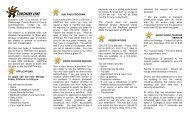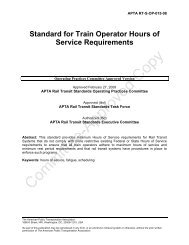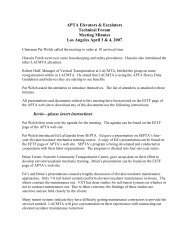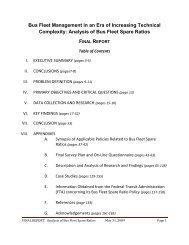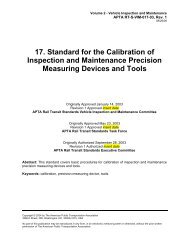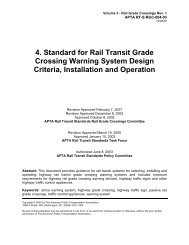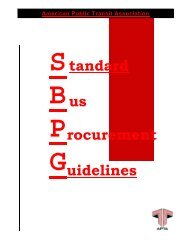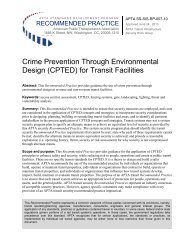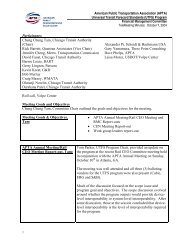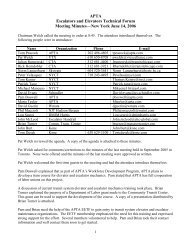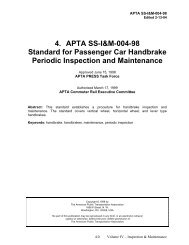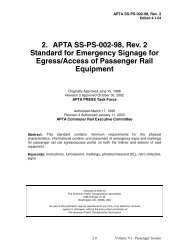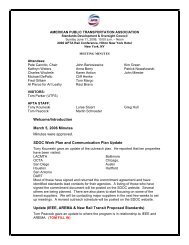Table of Contents - APTAStandards.com
Table of Contents - APTAStandards.com
Table of Contents - APTAStandards.com
You also want an ePaper? Increase the reach of your titles
YUMPU automatically turns print PDFs into web optimized ePapers that Google loves.
eXtensible Markup Language (XML) is a standard for the <strong>com</strong>munication<br />
<strong>of</strong><br />
information in a text format that is structured, well formed and validated against a<br />
model (schema). XML grew out <strong>of</strong> Standard Generalized Mark Up Language<br />
(SGML), a<br />
presentation-oriented language designed to display information<br />
in printed and<br />
electronic form in a wide variety <strong>of</strong> formats. Hyper Text Mark Up Language (HTML),<br />
the language <strong>of</strong> web browsers, is another cousin <strong>of</strong> XML. XML focuses on data<br />
structures and document formatting. The data can be validated for both structure and<br />
content, to whatever extent desired by the schema designer.<br />
OFX is based on XML, a “tagged” protocol, where each aggregate and data element has<br />
a name. The data is presented as a serial string, where<br />
each aggregate, or data element<br />
is preceded by a “” and followed by a ““. Naming <strong>of</strong> tags<br />
within an XML schema is <strong>com</strong>pletely up to the user, as is their organization<br />
and<br />
structure.<br />
The entire message strings can be encrypted or <strong>com</strong>pressed, or individual<br />
aggregates can be encrypted. All that is required is that both the sender and the<br />
receiver operate the same schema to define the contents<br />
<strong>of</strong> the messages. This makes<br />
<strong>com</strong>munication among different <strong>com</strong>puter architectures<br />
very simple, since they only<br />
have to agree on a character representation (normally ASCII) and a schema. Binary,<br />
Boolean, decimal and bitwise data are all represented as character data during<br />
transmission. Attributes can further define a tag’s values<br />
by permitting defaults and<br />
mandating content or enumerations <strong>of</strong> acceptable<br />
values. For example, a “rideroute”<br />
aggregate might consi st <strong>of</strong> a bus id, a route id and a direction<br />
as illustrated in Exhibit<br />
4.3-1.<br />
Exhibit 4.3-1 Example Rideroute Aggregate<br />
<br />
1456<br />
2671<br />
inbound<br />
<br />
In order to <strong>com</strong>municate among a number <strong>of</strong> parties or organizations, schemas are<br />
being standardized within many industries and groups with <strong>com</strong>mon needs. One such<br />
schema that defines tags attributes and aggregates for the financial <strong>com</strong>munity is OFX.<br />
The<br />
Open Financial Exchange specification is publicly available for implementation by<br />
any financial institution or vendor. As <strong>of</strong> September 2003, over 2400 banks and<br />
brokerages, as well as major payroll processing <strong>com</strong>panies support OFX. The latest<br />
version <strong>of</strong> OFX as <strong>of</strong> July 2004 is version 2.0.1.<br />
4.3.2 Applicability to UTFS Effort<br />
Althou gh a well-defined and widely implemented specification, OFX, in its current<br />
form, does not provide schemas that are applicable to the efforts <strong>of</strong> the UTFS.<br />
However, it certainly serves as a viable model for the development <strong>of</strong> a similar transit<br />
industry standard based on XML. Even though XML is admittedly bulky, it should<br />
Page 32



